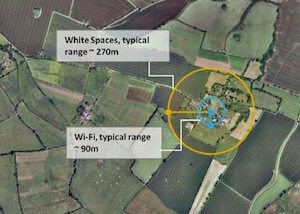Licensed spectrum came into being for a reason. In the early days of radio, unlicensed radio stations in urban areas regularly got into "power wars" with rival stations, leading to plenty of static. Compared to this free-for-all, the licensing of radio stations in the US, and then the creation of the Federal Communications Commission, helped to solve such problems.
But licensed spectrum created problems of its own. The major one involved the difficulty and expense of getting a license, a problem that continues to throw up huge barriers to entry for any new company that wants to launch a national cell phone network of its own.
Even under its most pessimistic scenarios, white spaces WiFi should generate billions of dollars each year in value. And that's in the US alone.
Over the last decade, though, unlicensed spectrum has really come into its own in the consumer space— cordless phones, WiFi, Bluetooth, and baby monitors all take advantage of it. Now, unlicensed broadband is coming to the 700MHz spectrum, filling in the gaps between UHF television channels. The impact of this much prime, unlicensed spectrum could be significant, generating up to $14.9 billion of value per year in the US alone.
Oh—and it could also help with global warming.
Billions and billions
Those are the conclusions of the new report (PDF) out from European consultancy Perspective, authored by a former economist for British telecoms regulator Ofcom. The report focuses largely on the economic and social benefits of running unlicensed WiFi-style networking protocols in the TV white spaces. The report was paid for by Microsoft—no surprise, since the company is doing significant research into the unfortunately named "WhiteFi" protocol.
The Perspective report concludes that WhiteFi, or something like it, will produce serious innovation, stimulating sales of WiFi devices and generating additional value through the faster speeds and wider coverage that white space devices can provide. That translates into an annual economic value of up to $14.9 billion on the high end, with more likely results in the $5 billion a year range.
While the report itself admits that "the exact validity of the assumptions of this modeling exercise can be questioned," it points out that even under its most pessimistic scenarios, white spaces WiFi should generate billions of dollars each year in value. And that's in the US alone; if the rest of the world adopts similar licensing strategies, that value could skyrocket.
These devices will operate in spectrum that has been used for television signals, signals that can travel up to 50 miles. When white spaces devices were first being considered, this led to wild fantasies about transmitters that could cover entire cities. As the report points out, though, television broadcasts are one-way and could rely on super high powered transmitters; sticking one of these things on the roof of your house, however, is not an option. Because of the power requirements placed on home devices, Perspective estimates that white space WiFi will have an operational diameter three times greater than 2.4GHz (the current standard) WiFi.

Still, that sort of increase is significant. A single indoor access point can easily cover an entire building, while outdoor access points should be able to cover small towns and villages in their entirety. Running a single fiber optic cable into town and hooking it up to a single white spaces transmitter should be significantly less expensive than wiring up entire rural areas.
Water and white space
This is one of the expected uses for the technology, but we haven't heard much about how white space devices will save the planet. Perspective argues that the new transmitters will make all sorts of new sensors viable in places where wired connections would be impractical and where current wireless connections (such as WiFi) simply don't reach far enough.
The main example given is automated irrigation systems that can reduce the water use on farms by 30 to 60 percent. Rather than spraying water indiscriminately, these systems work by installing tiny sensors throughout fields and vineyards to measure water levels, sunlight levels, and other agricultural data. The results are regularly beamed back to a central computer that aggregates all the information and irrigates only those areas that need it — and only for the amount of time they need it.
The much longer range and the lower power requirements of broadcasting at low frequencies make white space devices natural for these sorts of applications. Still, one gets the sense in this section of the report that one has reached the "kitchen sink" stage, one where all sorts of possible goods are simply tossed out in order to make the technology sound even more attractive.
The summary basically admits this, pointing out that it is a "cursory treatment" of social issues, that the "modeling conducted above is merely indicative," and that white space devices "might" work well in such areas.
But you don't need to believe that white spaces WiFi will save the planet in order to see the huge potential benefits of the technology (always assuming that it does not, as some doomsday pundits predict, destroy over-the-air TV broadcasting and wireless microphone use). As Perspective points out, the white spaces will increase unlicensed spectrum in the US between 9 and 22 percent, depending on how much space is open in a given area.
Given the innovation that has already occurred in the tiny slivers (see chart above) of unlicensed spectrum available to date, here's hoping that the engineering minds behind white spaces devices succeed in avoiding interference and bringing more bandwidth to wireless broadband. And if the technology can cut farm water use in half, that's a pretty significant bonus.
reader comments
44